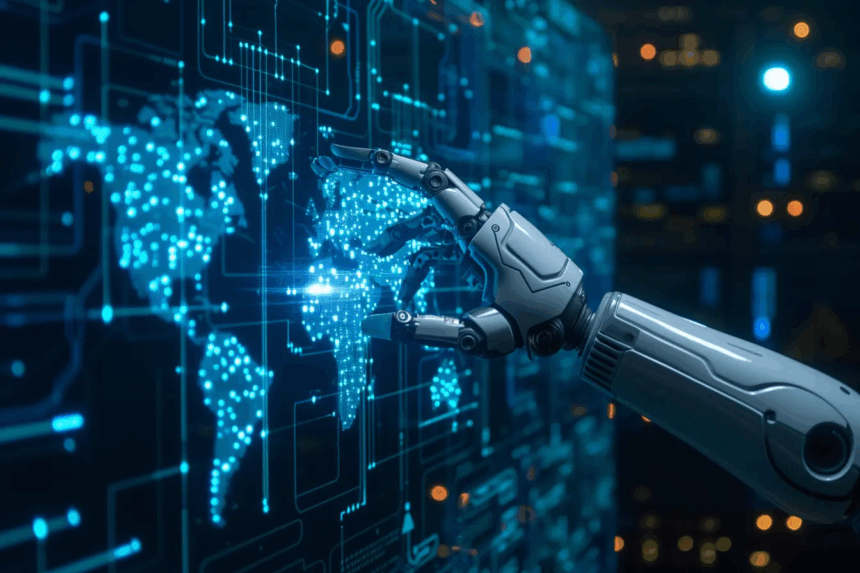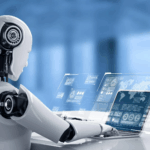Artificial Intelligence has rapidly moved from experimental research labs to powering real-world business applications across industries. At the center of this transformation is Generative AI — a branch of AI that can create new content, designs, code, and even entire business workflows.
In the past five years (2020–2025), generative AI case studies have shown us how companies of all sizes — from startups to global enterprises — are using AI to reduce costs, improve efficiency, and unlock creativity at scale. These case studies provide powerful insights, not just into the technology itself, but into how businesses can adopt generative AI responsibly and strategically.
In this article, we’ll explore real-world generative AI case studies across healthcare, finance, retail, media, and more. You’ll discover how AI is transforming industries, the benefits it brings, and the lessons companies are learning along the way.
👉 Whether you’re an AI enthusiast, business innovator, or executive, this guide will help you understand the practical value of generative AI in 2025 and how these case studies can inform your own strategy.
The Rise of Generative AI (2020–2025)
Between 2020 and 2025, Generative AI shifted from novelty to necessity. What began as experimental text and image generation tools has now matured into powerful business applications transforming industries worldwide.
Early Developments (2020–2022)
- OpenAI’s GPT-3 (2020) demonstrated the power of large language models (LLMs), sparking global interest.
- Image generators like DALL·E and MidJourney began producing realistic visuals, accelerating creative workflows.
- Early adoption was mostly by tech-savvy startups and researchers testing AI’s creative potential.
Expansion & Democratization (2022–2023)
- Tools like ChatGPT brought generative AI into the mainstream, attracting millions of users within months.
- Businesses discovered cost savings and efficiency gains, from AI-written marketing copy to AI-assisted coding.
- AI became accessible to non-technical professionals via user-friendly platforms like Jasper AI, Canva AI, and Writesonic.
Enterprise Integration (2023–2024)
- Fortune 500 companies began incorporating generative AI into healthcare, finance, retail, and media workflows.
- AI models advanced to handle multimodal inputs — text, image, video, and audio combined.
- Generative AI entered boardroom strategies, influencing digital transformation agendas.
The Current Landscape (2025)
- The generative AI market is projected to surpass $100B in value by 2030.
- Businesses now view AI as a strategic partner, not just a tool.
- Real-world generative AI case studies highlight tangible results:
- Faster product design cycles.
- Lower operational costs.
- Improved customer experiences.
Key takeaway: By 2025, generative AI is no longer experimental — it’s a core driver of innovation and competitive advantage.
Generative AI Case Studies by Industry
1. Healthcare
Healthcare has emerged as one of the most impactful sectors for generative AI adoption. With massive datasets in genomics, medical imaging, and patient records, AI is helping to accelerate diagnosis, drug discovery, and personalized medicine.
Case Study 1: AI in Medical Imaging
A major hospital network integrated a generative AI model trained on radiology scans to support doctors in identifying early signs of lung cancer. The AI not only flagged potential anomalies but also generated visual heat maps highlighting areas of concern. This helped radiologists detect cases 20% faster and reduced misdiagnosis rates.
Case Study 2: Drug Discovery with Generative AI
Pharmaceutical companies are leveraging generative AI to design new molecules for potential drugs. For example, one leading biotech firm used AI to create novel drug candidates for rare diseases, cutting the research timeline from years to months. The ability of AI to generate and simulate thousands of molecular combinations drastically reduced R&D costs.
Benefits in Healthcare
- Faster diagnosis and reduced human error.
- Accelerated drug discovery pipelines.
- Personalized patient care with AI-generated treatment suggestions.
Challenges
- Regulatory hurdles for AI-generated medical solutions.
- Data privacy concerns with sensitive patient data.
- Need for human oversight in life-critical decisions.
Takeaway
Healthcare generative AI case studies highlight that while AI cannot replace doctors, it can significantly augment their decision-making, saving lives and improving efficiency.
2. Finance
The finance sector has always been data-heavy, making it a natural fit for generative AI applications. From fraud detection to compliance reporting, banks and financial institutions are adopting AI to reduce risks, improve decision-making, and automate manual processes.
Case Study 1: Fraud Detection & Transaction Monitoring
A leading European bank implemented generative AI models to simulate fraudulent transaction patterns. By generating synthetic data of possible fraud attempts, the system trained fraud-detection algorithms to recognize new scams faster. As a result, the bank reduced false positives by 30% and caught emerging fraud tactics before they caused major losses.
Case Study 2: Automated Compliance Reporting
Regulatory reporting in finance often requires thousands of pages of structured documents. A global investment firm adopted a generative AI system that automatically produced compliance reports in multiple formats, summarizing key risks and anomalies. This reduced reporting time by 70%, saving millions in operational costs.
Case Study 3: Personalized Financial Advice
Fintech startups are now using generative AI to provide personalized financial recommendations. One popular app generates customer investment summaries and future projections tailored to their goals, creating experiences similar to having a virtual financial advisor.
Benefits in Finance
- Faster fraud detection and prevention.
- Reduced costs in compliance and audit processes.
- Personalized customer experiences at scale.
Challenges
- Strict regulatory oversight in financial data usage.
- Data security concerns with sensitive financial transactions.
- Need for transparency in AI-driven decision-making.
Takeaway
Finance-related generative AI case studies show that AI is not only improving efficiency but also building safer and more customer-centric financial services.
3. Retail & E-commerce
Retail and e-commerce companies face constant pressure to personalize shopping experiences, optimize operations, and create engaging content. Generative AI has become a game-changer, allowing brands to generate product descriptions, personalized recommendations, and even new product designs faster than ever before.
Case Study 1: Personalized Shopping Recommendations
A global e-commerce giant integrated generative AI into its recommendation engine. Instead of generic “customers also bought” suggestions, the AI generated context-aware recommendations based on browsing behavior, purchase history, and even real-time trends. This resulted in a 20% uplift in average order value.
Case Study 2: AI-Generated Product Descriptions
A fashion retailer adopted AI to automatically generate SEO-friendly product descriptions across thousands of SKUs. What used to take their content team weeks was reduced to hours, enabling faster product launches. Customers reported better clarity in product details, and the site experienced improved search visibility.
Case Study 3: Virtual Storefronts & Visual Merchandising
One innovative furniture retailer used AI-generated visuals to allow shoppers to preview products in different styles and environments. By merging generative AI with AR/VR experiences, customers could “see” how a sofa would look in their living room before buying, reducing returns by 15%.
Benefits in Retail & E-commerce
- Hyper-personalized shopping experiences at scale.
- Faster content creation for websites and marketing campaigns.
- Reduced returns through AI-generated product previews.
- Better engagement with visual and interactive content.
Challenges
- Risk of inaccurate product descriptions if AI is not carefully supervised.
- Over-automation could lead to “generic” branding if not monitored.
- High integration costs for smaller retailers.
Takeaway
Retail generative AI case studies prove that AI doesn’t just improve efficiency — it drives revenue growth and customer satisfaction. From product personalization to virtual merchandising, retailers adopting AI are building a competitive edge in 2025.
4. Media & Entertainment
The media and entertainment industry has seen some of the most disruptive use cases of generative AI. From AI-generated scripts and music to automated video editing and personalized content, companies are rethinking how content is created, distributed, and monetized.
Case Study 1: News Summarization & Content Drafting
A global news organization adopted generative AI to summarize breaking news stories into multiple formats — long articles, short social media snippets, and even audio scripts for podcasts. This allowed journalists to focus on fact-checking and investigative reporting while AI handled routine updates. As a result, they cut content production time by nearly 50%.
Case Study 2: AI in Film & Video Production
A film studio experimented with AI-generated storyboards and dialogue drafts to speed up pre-production. Instead of spending weeks on conceptual designs, the studio used generative AI to create visual previews of scenes and alternative scripts. This significantly reduced costs and gave directors more creative options before filming began.
Case Study 3: Personalized Content in Streaming Platforms
Streaming platforms are leveraging AI to generate personalized movie trailers and highlight reels for users. One leading OTT service tested AI-created “micro-trailers” based on viewing habits, which increased user engagement by 25% compared to generic trailers.
Benefits in Media & Entertainment
- Faster content creation and adaptation across multiple formats.
- Cost savings in pre-production and editing workflows.
- Hyper-personalized user experiences that increase engagement.
Challenges
- Risk of AI-generated content being too formulaic or lacking originality.
- Ethical concerns around deepfakes and content authenticity.
- Job displacement concerns for creative professionals.
Takeaway
Media-related generative AI case studies demonstrate that while AI won’t replace human creativity, it enhances efficiency and personalization, helping companies deliver more content faster and tailor experiences to individual users.
5. Manufacturing & Logistics
Manufacturing and logistics are industries where efficiency, precision, and predictive planning are critical. Generative AI has proven to be a powerful ally, helping companies optimize product design, reduce waste, and improve supply chain management.
Case Study 1: AI-Driven Product Design & Prototyping
A global automotive company adopted generative design AI tools to create lightweight yet durable components for electric vehicles. By generating and simulating thousands of design variations, the AI identified the most efficient designs, cutting R&D time by 40% and reducing material costs.
Case Study 2: Supply Chain Optimization
A large logistics provider used generative AI to model supply chain disruptions (such as strikes, weather events, or fuel price spikes). The AI simulated alternative scenarios and generated contingency plans, helping the company reduce delivery delays by 25% during real-world disruptions.
Case Study 3: Predictive Maintenance with Generative Models
In a smart factory setup, generative AI was applied to create synthetic sensor data that trained predictive maintenance systems. Machines could then “anticipate” potential failures, reducing downtime by 30% and saving millions annually in repair costs.
Benefits in Manufacturing & Logistics
- Faster and more innovative product designs.
- Reduced material waste and R&D costs.
- Improved supply chain resilience.
- Lower downtime through predictive maintenance.
Challenges
- Integration with legacy manufacturing systems can be costly.
- High-quality training data is essential for accurate predictions.
- Workforce upskilling is required to manage AI-driven operations.
Takeaway
Manufacturing and logistics generative AI case studies show that AI doesn’t just support efficiency — it enables innovation and resilience in industries where margins are thin and operational risks are high.
Benefits of Generative AI for Businesses
The generative AI case studies we’ve covered highlight more than just technology—they show how companies are achieving measurable business outcomes. Below are the key benefits businesses across industries are reporting.
Accelerated Innovation
Generative AI dramatically reduces the time-to-market for new products, services, and content.
- In manufacturing, AI shortens design cycles from months to weeks.
- In media, AI enables instant drafts of articles, scripts, or videos.
- In retail, thousands of SEO-friendly product descriptions can be generated in hours.
Cost Reduction
Case studies across industries confirm substantial cost savings:
- Fewer human hours spent on repetitive tasks.
- Reduced material waste in design and production.
- Lower R&D expenses thanks to AI-driven simulations.
A pharmaceutical company using AI for drug discovery saved millions in trial-and-error costs by simulating molecule designs before lab testing.
Enhanced Personalization
Personalization is no longer a luxury—it’s an expectation. Generative AI allows businesses to deliver tailored experiences at scale:
- E-commerce platforms suggest products based on individual user behavior.
- Streaming services create personalized trailers and highlight reels.
- Finance apps generate custom investment strategies for each client.
Improved Efficiency & Productivity
Generative AI reduces bottlenecks by taking over repetitive, labor-intensive tasks.
- Banks automate compliance reports.
- Media outlets auto-generate news summaries.
- Customer support uses AI chatbots to draft responses instantly.
This enables human employees to focus on high-value strategic work instead of routine tasks.
Competitive Advantage
Adopting AI isn’t just about efficiency—it’s about staying ahead. Businesses using generative AI often report:
- Higher customer satisfaction.
- Faster innovation cycles.
- Stronger digital transformation outcomes compared to competitors.
Scalability for Startups & Enterprises
Whether a startup or a global enterprise, AI adapts to scale.
- Startups leverage AI to look “bigger” by automating workflows.
- Enterprises integrate AI across global teams to maintain consistency and efficiency.
Takeaway:
The biggest benefit of generative AI is that it allows businesses to do more, faster, and better, while still keeping costs in check. It creates a powerful multiplier effect: lower costs, faster innovation, and better customer experiences all at once.
Challenges & Risks in Generative AI Adoption
While generative AI case studies highlight major wins, businesses must also be aware of the risks and challenges that come with adoption.
Data Privacy & Security
Generative AI often requires access to large volumes of sensitive data — medical records, financial transactions, or personal user behavior. This raises concerns:
- Risk of data leaks during training or deployment.
- Compliance issues with regulations like GDPR or CCPA.
- Potential misuse of confidential business information.
Ethical Concerns & Bias
AI systems are only as good as the data they are trained on. If training data contains biases, AI outputs may:
- Reinforce gender, racial, or cultural stereotypes.
- Generate misleading or unfair recommendations.
- Cause reputational harm to businesses.
Accuracy & Reliability
Not every AI-generated output is correct.
- In healthcare, inaccurate predictions could endanger patients.
- In finance, flawed AI-generated reports could cause compliance failures.
- In media, errors in AI-written news could spread misinformation.
Human oversight remains essential.
Integration with Legacy Systems
Many enterprises struggle to integrate AI into older IT systems.
- Costly infrastructure upgrades may be required.
- Staff training and upskilling are needed to manage new workflows.
Job Displacement Fears
Generative AI raises concerns about automation replacing human roles.
- Content creators worry about AI-written blogs and scripts.
- Customer service agents fear replacement by AI chatbots.
- Manufacturing workers face automation of design and quality checks.
Reality: AI augments humans rather than replaces them, but managing this perception is crucial.
Regulatory Uncertainty
Governments are still catching up with AI regulations.
- New laws could impose restrictions on AI-generated content.
- Businesses risk non-compliance penalties if they adopt AI too aggressively without legal checks.
Takeaway:
Generative AI adoption is not a silver bullet. Businesses must weigh benefits against risks, ensure robust governance, and always keep human oversight in the loop.
Lessons from Generative AI Case Studies
The generative AI case studies we’ve reviewed across industries reveal more than technological breakthroughs — they show patterns and lessons that businesses of all sizes can learn from.
AI Works Best as an Augmentation, Not a Replacement
Across healthcare, finance, and media, one theme is clear: AI is most effective when it supports humans, not replaces them.
- Doctors still interpret medical imaging results, but AI highlights anomalies faster.
- Journalists still fact-check, but AI drafts first versions of articles.
- Designers still lead the creative process, but AI speeds up prototyping.
👉 The best outcomes come from human + AI collaboration.
Data Quality Determines Success
Generative AI is only as good as the data it’s trained on. Case studies show that:
- In finance, poor data leads to flawed fraud detection.
- In healthcare, limited datasets risk bias in medical predictions.
- In retail, incomplete customer data can harm personalization efforts.
👉 Businesses must invest in high-quality, diverse, and unbiased datasets.
Speed is a Strategic Advantage
Generative AI accelerates innovation — companies that adopt early gain a first-mover advantage.
- Retailers deploying AI recommendations saw higher sales before competitors caught up.
- Manufacturers using AI for design reduced product development cycles by months.
- Media firms that automated summaries delivered news faster than rivals.
👉 Early adoption creates a compounding advantage in efficiency and customer loyalty.
Ethical & Regulatory Readiness is Crucial
Enterprises that address ethics and compliance upfront scale more successfully.
- Transparent AI adoption builds trust with customers and regulators.
- Firms ignoring bias, consent, or data privacy face reputational and legal risks.
👉 Companies should pair technical AI strategies with clear ethical frameworks
AI Creates Value Across the Value Chain
Case studies show generative AI’s impact isn’t limited to one department:
- R&D: Faster design and prototyping.
- Operations: Predictive maintenance and supply chain optimization.
- Marketing: Content generation and personalization.
- Customer Experience: Chatbots and AI assistants for instant support.
👉 Businesses should think beyond single use cases and explore end-to-end AI adoption.
Takeaway:
The biggest lesson is that generative AI is not just a tool but a strategic enabler. Companies that invest early, manage risks responsibly, and integrate AI into core workflows will shape the next decade of industry leadership.
FAQs About Generative AI Case Studies
1. What is a generative AI case study?
A generative AI case study is a real-world example of how businesses, researchers, or organizations use generative AI technologies to solve problems or improve operations. It documents the use case, process, results, and lessons learned.
2. Why are generative AI case studies important?
They show how AI delivers practical value beyond theory. Instead of abstract promises, businesses see:
- Measurable results (e.g., faster design cycles, reduced costs).
- Industry-specific applications (healthcare, finance, retail, etc.).
- Best practices to avoid risks and maximize ROI.
3. Which industries benefit most from generative AI?
The leading sectors include:
- Healthcare → medical imaging, drug discovery.
- Finance → fraud detection, compliance automation.
- Retail → product recommendations, content generation.
- Media & Entertainment → news automation, film pre-production.
- Manufacturing & Logistics → design optimization, predictive maintenance.
4. Can small businesses use generative AI?
Yes ✅. While enterprise case studies dominate headlines, small businesses also benefit. Examples include:
- Local e-commerce stores using AI to generate product descriptions.
- Marketing agencies using AI for ad copy and social media content.
- Small manufacturers leveraging AI for prototype designs.
Affordable tools like Jasper AI, Canva AI, and Copy.ai make adoption easier.
5. What challenges do case studies reveal about generative AI?
Common challenges include:
- Data privacy and security concerns.
- Risk of bias in AI-generated outputs.
- Integration costs with legacy systems.
- Need for human oversight to maintain accuracy.
6. Are generative AI case studies relevant in 2025?
Absolutely. By 2025, case studies highlight mature adoption, not just pilot projects. They showcase scalable business results, making them more reliable for companies planning their own AI strategies.
7. How do generative AI case studies help decision-makers?
They provide evidence-based insights. Instead of guessing AI’s value, executives can benchmark against existing successes in their industry, assess ROI, and adopt strategies proven to work elsewhere.
8. Where can I find more generative AI case studies?
Aside from this article, you can follow:
- Research reports from McKinsey, Gartner, and PwC.
- Company blogs of AI leaders like OpenAI, Google DeepMind, and Anthropic.
- Academic case studies from journals and universities.
👉 For more curated insights, keep checking AI of the Decade for regular updates.
Conclusion
The past five years have proven one thing: generative AI is no longer experimental — it’s transformative. From healthcare to finance, retail, media, and manufacturing, the case studies we’ve explored highlight how AI is being applied to real-world problems with measurable results.
Across industries, companies are using generative AI case studies as proof points to:
- Validate investment decisions.
- Reduce operational inefficiencies.
- Personalize customer experiences at scale.
- Accelerate research, design, and product launches.
But adoption also comes with challenges — data privacy, ethical concerns, and integration hurdles remain top considerations. The lesson is clear: success with generative AI depends on responsible deployment, high-quality data, and human oversight.
For startups, AI creates a chance to compete with giants by automating workflows and scaling quickly. For enterprises, it delivers cost savings and innovation at scale. In both cases, AI isn’t just another tool — it’s a strategic enabler of digital transformation.
👉 If you want to stay ahead of the curve, study these case studies, learn from their lessons, and start experimenting with AI in your own workflows.
For more insights, guides, and updates on how AI is shaping the future, visit AI of the Decade — your trusted source for everything AI.











